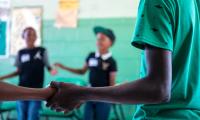Putting human rights on the curriculum

All over the world, school children learn national and global history, religion, science, and social studies, among other subjects. But what about human rights? How can human rights be integrated into these subjects, fit for children in primary and secondary schools, and tailored to their national context? A new guide by the Danish Institute for Human Rights might have the answer. A strong curriculum, including human rights education, is key to ensuring that future generations understand their rights and respect and uphold the rights of others.
Therefore, the Danish Institute for Human Rights has developed a new guide to help support other national human rights institutions in their work to embed human rights into national education programmes. The guide presents a step-by-step approach to the different phases of HRE curriculum development, suggesting sample curricula on human rights along the way.
Several international standards and conventions call for human rights education across the globe, holding states accountable for human rights education implementation. The UN Declaration on Human Rights Education and Training, for instance, states in its first article that all persons should have access to human rights education. Similarly, the 2030 Agenda's fourth Sustainable Development Goal (SDG) focuses on inclusive and equitable quality education, with SDG Target 4.7 specifically calling for human rights education.
Making a complicated task easier
Globally, national human rights institutions (NHRIs), such as the Office of Public Defender of Georgia, work to promote and protect human rights, and have unique insight into and knowledge of their national human rights situations. But as Medea Gugeshashvili, head of the Human Rights Education Department of Georgia’s Public Defender’s Office puts it, "It is one thing for us to have a unique knowledge of the human rights situation in our country, but it is more complicated to know how to infuse human rights in the general education system."
Gugeshashvili sees the guide’s potential for making her office’s work on integrating human rights into Georgia's educational programmes somewhat easier, saying it will help in developing new learning materials and setting clear goals for human rights education:
"Currently, the Public Defender’s Office is cooperating with the Pedagogical Faculties and other higher educational institutions to integrate human rights issues in future teacher educational programs. The guide will help us develop the educational materials – define the purpose of the human rights education, identify relevant issues to integrate in the programs and define the outcomes that future teachers have to obtain as a result of their instruction on human rights issues," says Medea Gugeshashvili.
Moving away from traditional education
In other countries around the world, Ministries of Education are starting to move away from more traditional, textbook-centred and teacher-directed education, solely driven by content, towards outcome-based education, where there is an increased focus on whether the students are actually learning. Rather than having students memorise and recite human rights conventions and articles, the goal is to increasingly equip them to analyse and apply human rights knowledge. Curriculum is therefore planned around specific goals and outcomes. Defining clear learning outcomes – the knowledge and skills students should acquire at the end of their education – is key in the curriculum development process. From now on, with the new guide, this part of the process will be made easier as far as integrating human rights is concerned:
“The guide opens new possibilities to assess how the Georgian national curriculum is organized. In other words, it enables us to evaluate how developed the curriculum is in that sense. The core issue in this process is whether the curriculum can be classified as an outcome-based or content-based one," says Medea Gugeshashvili.
By 2030 ensure all learners acquire knowledge and skills needed to promote sustainable development, including among others through education for sustainable development and sustainable lifestyles,human rights, gender equality, promotion of a culture of peace and non-violence, global citizenship, and appreciation of cultural diversity and of culture’s contribution to sustainable development.
To monitor SDG Target 4.7, the Danish Institute for Human Rights has developed the SDG 4.7 / Human Rights Education Monitoring Tool. With the tool, national human rights institutions and state actors can collect data on progress in the human rights education elements of SDG 4.7 and the World Programme of Human Rights Education. In their collection of data using this tool, a number of NHRIs have identified gaps in the integration of human rights education in national curricula.
The tool is available at: https://sdg47-hre.humanrights.dk/
The guide has been made with support from the Danish International Development Agency (DANIDA) and is now available online.
